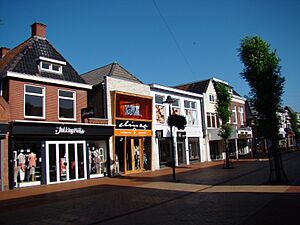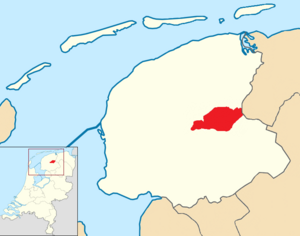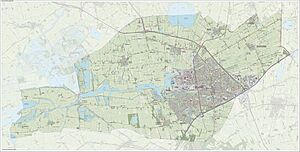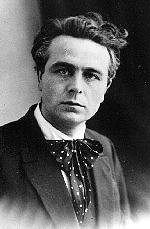Smallingerland facts for kids
Quick facts for kids
Smallingerland
Smellingerlân
|
|||
|---|---|---|---|

Street in Drachten
|
|||
|
|||

Location in Friesland
|
|||
| Country | Netherlands | ||
| Province | Friesland | ||
| Government | |||
| • Body | Municipal council | ||
| Area | |||
| • Total | 126.17 km2 (48.71 sq mi) | ||
| • Land | 118.24 km2 (45.65 sq mi) | ||
| • Water | 7.93 km2 (3.06 sq mi) | ||
| Elevation | 1 m (3 ft) | ||
| Population
(May 2014)
|
|||
| • Total | 55,505 | ||
| • Density | 469/km2 (1,210/sq mi) | ||
| Time zone | UTC+1 (CET) | ||
| • Summer (DST) | UTC+2 (CEST) | ||
| Postcode |
8497, 9200–9223
|
||
| Area code | 0512, 0566 | ||
Smallingerland is a municipality located in the province of Friesland in the Netherlands. It is known for its main town, Drachten, and its unique history tied to peat digging.
Contents
Towns and Villages in Smallingerland
Smallingerland is made up of one main town and several smaller villages. These are:
- Boornbergum
- De Tike
- De Veenhoop
- De Wilgen
- Drachten (the main town)
- Drachtstercompagnie
- Goëngahuizen
- Houtigehage
- Kortehemmen
- Nijega
- Opeinde
- Oudega
- Rottevalle
- Smalle Ee
Exploring the History of Smallingerland
The name "Smallingerland" comes from a small village called Smalle Ee. This village used to have an important monastery, which is a place where monks or nuns live. In the 1300s, the yearly market (or fair) in Smalle Ee was as important as those in bigger cities like Leeuwarden and Dokkum.
How Drachten Grew
The main town, Drachten, got its name from an old Frisian word, Darch. This word means "peaty soil", which is a type of soil made from decayed plants. Drachten became important in the region around 1641. This was when a businessman from Holland decided to dig for peat there.
Peat is a type of fuel, like coal, formed from old plants in wet areas. About 800 workers were hired to dig the Drachtstervaart canal. This canal helped transport the peat. Even though the peat business didn't last long, the canal led to other activities, like shipbuilding. You can still see the special peat bog landscape, especially near Drachtstercompagnie.
Drachten's Growth Since the 1950s
Since the 1950s, Drachten has grown very quickly. Today, it is a major center for the area. Besides Drachten, Smallingerland has thirteen smaller villages. The biggest village is Opeinde, with about 1,731 people. The smallest is Smalle Ee, with only 57 villagers.
A book from 1998, Het Gezicht van Smallingerland ("The Face of Smallingerland"), shares interesting details about the area's history. It describes how Drachten changed from a quiet place to a busy town.
The Importance of Peat Digging
In the 1600s, peat became a very important source of energy. It was used in homes and by industries. The demand for peat was very high in the fast-growing province of Holland. Most of the peat was transported by water, often using special boats.
Digging for peat brought a lot of activity to many villages. However, most of the money did not go to the peat cutters themselves.
The Drachten Associates and Canal Building
In 1641, farmers in Drachten North and Drachten South made a deal with rich business people from Holland. These people were called the Drachten Associates. One of them was Passchier Hendriks Bolleman. The deal was that the peat in Smallingerland would be sent to industries in Holland.
To transport the peat by boat, the Drachtster Compagnonsvaart canal and two smaller canals were built. For a whole year, 800 workers dug every day. As people worked there, homes, storage places, inns, and businesses started to appear.
From Peat to Shipbuilding
The peat business didn't last long and even caused Passchier Bolleman to lose his money. But it led to the creation of Drachten. The Drachtstervaart canal brought in ships, and these ships needed services. This led to businesses like rope-yards, carpenter's yards, and forges (places where metal is shaped).
In 1746, the first real shipyard was built. At first, they only built wooden flatboats. But after 1895, they also started building ships with iron hulls. Another shipyard opened in 1902. Even today, traditional Frisian sailing boats called skûtsjes from these shipyards take part in big sailing events.
Drachten Becomes the Center
In the 1600s, the local leader (like today's mayor) was based in Oudega. Oudega had taken over the important annual markets from Smalle Ee. But after the Drachtstervaart canal was finished, the economic activities and markets moved to Drachten. Soon, the local government followed.
This is how Smallingerland is structured today: Drachten has over 44,000 people, and the thirteen surrounding villages have more than 10,000 people combined. Drachten is now a busy place with many homes and businesses. It is one of the best places for jobs in the north of the Netherlands. Drachten's shopping centers, nightlife, schools, and healthcare serve over 150,000 people from the surrounding area.
Notable People from Smallingerland
Many interesting people have come from Smallingerland, including:
- Professor Pieter Klazes Pel (1852–1919): A Dutch doctor and professor of internal medicine.
- Pier Pander (1864–1919): A Dutch sculptor and designer of medals.
- Herman Theodoor Colenbrander (1871–1945): A Dutch historian and academic.
- S.H. de Roos (1877–1962): A Dutch type designer and artist.
- Fedde Schurer (1898–1968): A Dutch teacher, journalist, and politician.
- Hendrik Kloosterman (1900–1968): A Dutch mathematician who studied number theory.
- Cisca Wijmenga (born 1964): A Dutch professor of Human Genetics.
- Zanger Rinus (born 1969): A Dutch singer.
- Erik Bosgraaf (born 1980): A Dutch recorder player and music expert.
- Tim Douwsma (born 1987): A Dutch singer.
- Iris Kroes (born 1992): A Dutch singer-songwriter and harpist.
- Maurice de Jong (born 1973): A Dutch composer and musician.
Sport Stars from Smallingerland
- Jan Lammers (1926–2011): A Dutch sprinter who competed in the 1948 Summer Olympics.
- Jeen van den Berg (1928–2014): A Dutch long track speed skater who competed in the 1956 and 1960 Winter Olympics.
- Alie Boorsma (born 1959): A retired speed skater who competed in the 1984 Winter Olympics.
Sister Cities
Smallingerland has a special connection with another city, called a twin town. This helps build friendships and understanding between different places.
Smallingerland also used to be twinned with Kiryat Ono, Israel.
See also
 In Spanish: Smallingerland para niños
In Spanish: Smallingerland para niños






